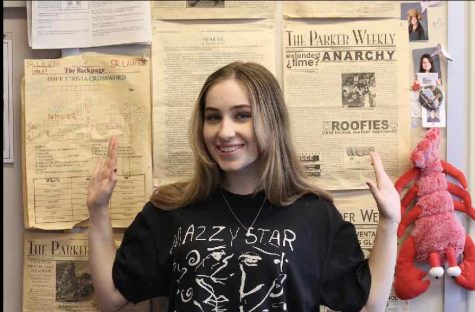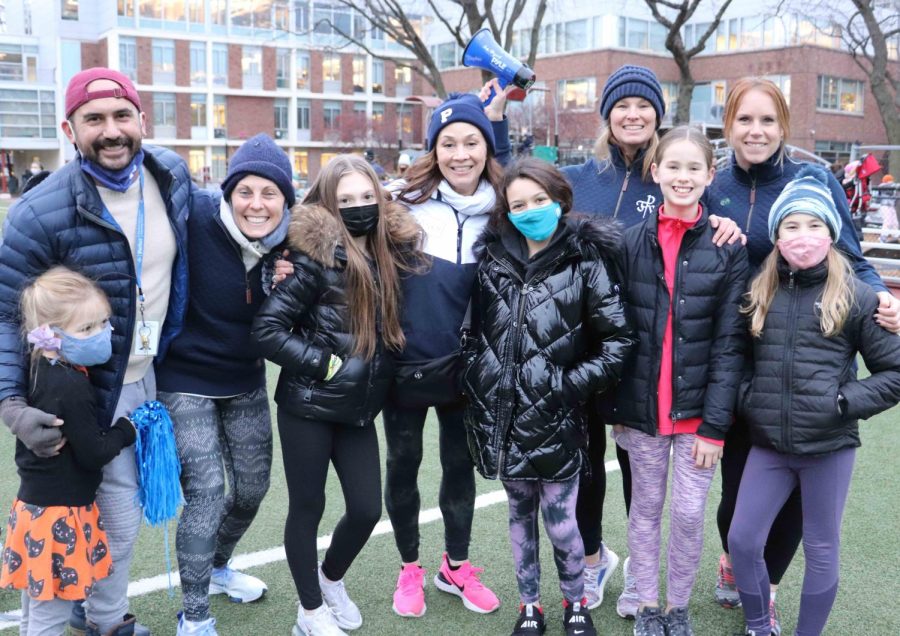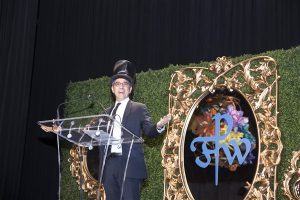The Life of the Parker Party
Parker Party Replaces Parker Auction, Fundraises for Financial Assistance
Photo credit: Chuck Lira
Lira and Parker Party Co-Chairs bundled, spirited, and Fun Run ready.
Share Your Parker Love! Your New Tumbler is Ready to Party! One-Stop Shop for Non-Stop Fun! Check a Parker parent’s inbox – it’s fundraising season.
The bi-annual Parker Auction is being re-designed as the Parker Party by Associate Director of Institutional Events Chuck Lira, alongside parent co-chairs Susan Brown, Jen Friedlander, Anny Gary, and Kira Price ’99 and around a 100 community volunteers.
Lira said the Parker Party hopes to feel less “formal” and more inclusive. “Raising a paddle to donate a large amount of money in front of a room full of people,” Lira said, “some people have felt a little uncomfortable.”
The live auction will still take place, but all bidding will be done by phone as the auctioneer announces each package and current bid on stage as the visual fundraising “thermometer” increases. The same format phone bid format will be used for the silent auction, released a week in advance.
Other adjustments to promote inclusivity at the auction itself is a move away from assigned, pre-requested tables and an expanded “Fun Under $100” section in the silent auction packages focused on affordability. Volunteer opportunities have been increased after working hours so more parents are able to donate time. Lira also formed a committee to engage new parents, where volunteers reach out to explain fundraising events and offer answers to “what we are doing, what do I wear, who do I show up with.”
In 2019, the Cooke and the Colonel fall fundraising event, once dinner parties held across Parker homes, was shifted to a cocktail party format at the Theater on the Lake. This switch to a more casual format, Lira reported, got positive reviews, which inspired, in part, the shift to the Parker Party.
“We loved being able to come in jeans,” Lira said. “We loved being able to socialize with one another throughout the entire evening. We didn’t have to sit down at a table and sit through a multi-course dinner.”
A survey of constituents with 266 responses, run by Lira’s parent co-chairs, confirmed this.
“We’re not really trying to recreate the wheel,” Lira said, “just maybe evolve it.”
The $1.2 million goal of the Parker Party will account for around 20% of the total allocated funds for Financial Assistance next year, John G. Levi Director of Development Brent Caburnay said. Part of this total is raised in smaller events like the Cookie Decorating Parties, Parker Spirit Experiences run by faculty and staff, and the Polar Party Fun Run, which raised $48,000.
“When we say ‘hey, we want you to participate in this fundraising effort.’ We do not say that for only 20% of the school,” Caburnay said. “We say that to every single person in the school. And it’s really to try to create, as much as possible, this level playing field of the way that you can engage with the school philanthropically.”
One in four students at Parker receive some percentage of financial assistance, supported by a budget of $5.5 million. That 25% is made up of 24% in the Lower School, 28% in the Intermediate and Middle School, and 48% in the Upper School.
Families re-apply every year with reports of their income, expenses, debts, and liabilities so the office can assess need and modify assistance accordingly.
Money is allocated into what Director of Enrollment and Financial Aid Karen Fisher calls four “buckets:” currently enrolled families, families previously paying full tuition whose circumstances change, families applying who are affiliated with the school, and newly admitted families with no previous affiliation. Affiliated families can be siblings or children of faculty, staff, and alumni.
Candidates are first ranked and recommended for admission before the financial assistance office reviews a candidate’s application for financial assistance. Once the family’s need is assessed, an allocation is made to the family, Fisher said.
The office’s caseload increased almost 20% in the last five years, from 161 to 190 caseloads as of 2021-22. The program aims to add as many participants as possible each year while avoiding “gapping” and accounting for all the currently enrolled families in bucket one.
“We don’t want to just admit a family and then drop them,” Fisher said. “We want to be able to support every student throughout their enrollment at Parker in a way that helps them be successful in the school.”
Even as the program increases its caseload, the human resources of the office have stayed the same. Fisher is currently advocating for an increase.
“In all of our interactions with our families, we want to have personal relationships, we want them to feel known by us and yet protect their confidentiality as well,” Fisher said. “With more program benefits and more participants, we need more human resources and more hard resources to be able to do that effectively.”
With the expanding program also comes expanding extracurricular benefits, recently moving to fully fund any student on FA traveling with the Model United Nations team after a letter from the 2020-21 and 2021-22 Upper School Captains.
The program hopes to grow their travel budget and summer opportunity budget, with a recent pilot program of funding for Parker Summers. The $70,000 allocated for collateral program benefits beyond tuition includes money for tutoring, educational diagnostics, meals, technology, college preparatory materials, and Parker P.M. and Plus.
That $5.5 million is funded not just by events like the Parker Party, but through a percentage of tuition revenue and the endowment. In his 18 years at Parker, Chief Financial Officer Bob Haugh has seen fundraising through the recession and the pandemic, with growth in the endowment from about $12 million to $70 million under the management of the Investment Committee branch of the board.
The school takes a rolling, three year average of the endowment and then withdraws up to 5% of that average from the account. Five percent is the cap for withdrawal, an independent school industry standard. As the endowment grows, this percent can contribute about 9% to the school’s revenue flow, what Haugh describes as “healthy.”
A part of that 5% is given to Fisher and the Financial Assistance program, along with 13.5% of tuition revenue. That 13.5% puts Parker around the “middle of the group” among 100 comparable peer independent schools they compare financial data with. Some schools give 20-22%, while some give 8-10%, but Parker is also in the middle of the range in most other measured categories.
“We always are able to support the families that are here,” Haugh said. “New families coming into the school that may need financial support, sometimes you get to a situation where we’re out of money, but by and large, because the endowment keeps growing and because we’re fundraising, that usually doesn’t happen.”
After the close of the “Founding our Second Century” capital campaign, which ran from 2003 to around 2014, the school is in the quiet phase of their next major fundraising push, which will be centered around growing the endowment and the Belden apartment building project.
“Everything that we’re going to roll out, when we do it, it resonates with our constituents,” Haugh said. “You don’t ever want to come out and say we want to do something that makes no sense – then people won’t participate.”
Even with increasing total tuition of $35,720 in JK to $40,950 senior year, the school does not charge 100% of its operating cost, which is why fundraising and endowment growth are necessary to keep up.
“The more money that we can build in our endowment, the less pressure there is to raise tuition,” Haugh said. “That creates a little bit more affordability.”
Access and Affordability, Caburnay said, are currently the top priorities for fundraising. “How can we provide opportunities for students that are faced with barriers to a Parker education?” Caburnay said. “How do we broaden our appeal to kids that are really outstanding kids, that could be so dynamic in our community and add a lot of knowledge and experience and voice.”
Along with that increased focus, as described by Caburnay and Haugh, there’s also been a shift in messaging around fundraising, such as the theme that all families benefit from financial assistance.
“We’ve been changing the language of financial aid and evolving it to a concept more of partnership and assistance and support,” Fisher said, “rather than being some type of a charity or award.”
Fisher said the FA program itself doesn’t resolve everything. “There are very subtle issues of class and difference that can impact a community,” she said. “If we don’t thoughtfully create conversation around those issues, you could end up with a community that is more fractured and less open.”
One of those fractures is the presence of donor names throughout the school. “Hopefully we do it tastefully and hopefully the families are happy,” Haugh said. “There’s always a risk, if your dad’s name is on a hall thing and your friend’s dad’s name is not, that kind of stuff happens, and you just hope that people understand the circumstances.”
Haugh said he’s not aware of undue donor influence in his time at Parker, a fact he attributes to values of integrity and equity.“If they come with inappropriate requests or something that’s a little bit too far over the line,” Haugh said, “we’re able to say, ‘that’s really not what we’re about.’”
“That doesn’t mean that those conversations didn’t happen, where someone was looking for special treatment and didn’t get it,” Haugh said.
Caburnay acknowledged the student narrative around donor influence, but said that Principal Dan Frank and the Administration and Faculty first identify what the needs are of the school and once those initiatives are approved, the Development Office is charged with identifying potential funders. This was done with the auditorium, library, and field renovations. “Yes, the perception exists, and we’re constantly trying to dispel that perception,” Caburnay said.
Another perception the Development Office is working to dispel is that any one gift to the school is more valuable than another. Caburnay said the philosophy of the office is that a $10 gift should be treated with as much respect as a $10 million gift, as is the model of stewardship events, where anyone who gave more than $1 was invited.
“What we want is everyone to feel like everybody owns a piece of the house,” Caburnay said. “We really do believe it from a philanthropic standpoint, that everybody can make a difference, whatever that might be.”















